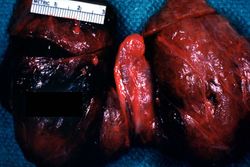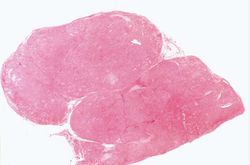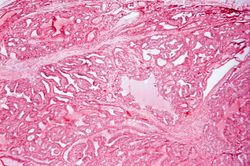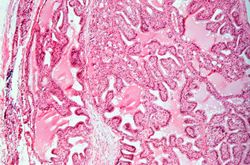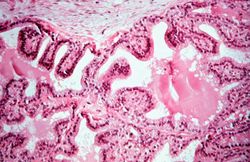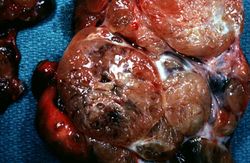Difference between revisions of "IPLab:Lab 6:Graves Disease"
Seung Park (talk | contribs) |
|||
| Line 15: | Line 15: | ||
File:IPLab6GravesDisease7.jpg|Closer view of cut surface of the thyroid with nodular goiter. Note the multilobular appearance of the tissue. | File:IPLab6GravesDisease7.jpg|Closer view of cut surface of the thyroid with nodular goiter. Note the multilobular appearance of the tissue. | ||
</gallery> | </gallery> | ||
| + | |||
| + | == Study Questions == | ||
| + | * <spoiler text="What is the immunologic mechanism responsible for Graves' disease?">Autoantibodies directed towards the TSH receptor of the thyroid cause stimulation of the thyroid leading to increased secretion of thyroid hormones and growth of the thyroid gland.</spoiler> | ||
| + | * <spoiler text="What role does genetics play in the predisposition to Graves' disease?">* Graves' disease is more common in females than males | ||
| + | * It has been linked to HLA-B8 and DR3 in whites but different haplotypes in Asians | ||
| + | * It has a familial predisposition | ||
| + | * It is more common in patients with other forms of autoimmune thyroid problems (e.g., Hashimoto's thyroiditis)</spoiler> | ||
| + | * <spoiler text="Does Graves' disease predispose to thyroid cancer?">There is little evidence to suggest an increased frequency of thyroid cancer in patients with Graves' disease.</spoiler> | ||
{{IPLab 6}} | {{IPLab 6}} | ||
[[Category: IPLab:Lab 6]] | [[Category: IPLab:Lab 6]] | ||
Revision as of 15:21, 21 August 2013
Clinical Summary[edit]
This 18-year-old girl presented with complaints of swelling in the neck, weight loss, bulging of the eyes, tremor, decreased heat tolerance, loose stools, and occasional palpitations. Physical examination revealed normal blood pressure, resting tachycardia of 110 beats per minute, mild exophthalmos, eyelid lag, and a diffusely enlarged thyroid gland. Pertinent laboratory findings were thyroxine (T4) level 30.8 mcg/dL, free thyroxine was 2.7 ng/dL, and thyroid stimulating hormone (TSH) was 0.22 mcIU/mL. She was given propylthiouracil until she became nearly euthyroid, at which time a thyroidectomy was done.
Autopsy Findings[edit]
The thyroid gland weighed 45 grams. It was beefy red in color and had a homogeneous fleshy consistency.
Images[edit]
Study Questions[edit]
A normal T4 level is 4 to 11 mcg/dL.
A normal free T4 level is 0.71 to 1.85 ng/dL.
A normal thyroid gland weighs 25 grams.
Nodular hyperplasia of the prostate--characterized by large discrete prostatic nodules--is a common disorder in men over 50 years of age. The nodules cause the prostate to be enlarged and to have an increased weight. The human prostate is surrounded by a restrictive capsule. These nodules cause increased pressure within the capsule which leads to constriction of the urethra as it passes through the prostate. Urethral constriction leads to retention of urine.
Autoimmune disorders involve an immune response directed at the host's own cells.
